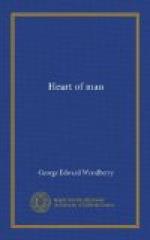Three ways connect the town with the lower world. The modern carriage road runs from the Messina gate, and, quickly dropping behind the northern spur, winds in great serpentine loops between the Campo Santo below and old wayside tombs, Roman and Arabic, above, until it slowly opens on the southern outlook, and, after two miles of tortuous courses above the lovely coves, comes out on the main road along the coast. The second way starts from the other end of the town, the gate toward Etna, and goes down more precipitously along the outer flank of the southern spur, with Mola (here shifted to the other side of the castle hill) closing the deep ravine behind; and at last it empties into the torrent of Selina, in whose bed it goes on to Giardini. The third, or short way, leaps down the great hollow of the spurs, and yet keeps to a ridge between the folds of the ravine which it discloses on each side, with here and there a contadino cutting rock on the steep hillsides, or a sportsman wandering with his dog; or often at twilight, from some coign of vantage, you may see the goats trooping home across the distant sands by the sea. It debouches through great limestone quarries on the main road. There, seen from below, Taormina comes out—a cape, a town, and a hill. It is, in fact, a long, steep, broken ridge, shaped like a wedge; one end of the broad lace dips into the sea, the other, high on land, exposes swelling bluffs; its back bears the town, its point lifts the castle.
This is the Taorminian land. What a quietude hangs over it! How poor, how mean, how decayed the little town now looks amid all this silent beauty of enduring nature! It could not have been always so. This theatre at my feet, hewn in the living rock, flanked at each end by great piers of massive Roman masonry, and showing broken columns thick strewn in the midst of the broad orchestra, tells of ancient splendour and populousness. The narrow stage still stands, with nine columns in position in two groups; part are shattered half-way up, part are yet whole, and in the gap between the groups shines the lovely sea with the long southern coast, set in the beauty of these ruins as in a frame. Here Attic tragedies were once played, and Roman gladiators fought. The enclosure is large, much over a hundred yards in diameter. It held many thousands. Whence came the people to fill it? I noticed by the




